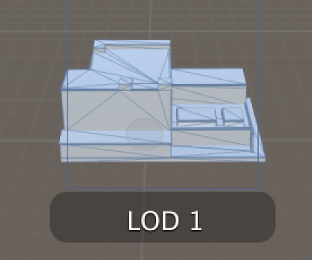Level of Detail (LOD)
When a GameObjectThe fundamental object in Unity scenes, which can represent characters, props, scenery, cameras, waypoints, and more. A GameObject’s functionality is defined by the Components attached to it. More info
See in Glossary in the sceneA Scene contains the environments and menus of your game. Think of each unique Scene file as a unique level. In each Scene, you place your environments, obstacles, and decorations, essentially designing and building your game in pieces. More info
See in Glossary is a long way from the cameraA component which creates an image of a particular viewpoint in your scene. The output is either drawn to the screen or captured as a texture. More info
See in Glossary, the amount of detail that can be seen on it is greatly reduced. However, the same number of triangles will be used to render the object, even though the detail will not be noticed. An optimisation technique called Level Of Detail (LOD) renderingThe process of drawing graphics to the screen (or to a render texture). By default, the main camera in Unity renders its view to the screen. More info
See in Glossary allows you to reduce the number of triangles rendered for an object as its distance from the camera increases. As long as your objects aren’t all close to the camera at the same time, LODA system for building multiplayer capabilities for Unity games. It is built on top of the lower level transport real-time communication layer, and handles many of the common tasks that are required for multiplayer games. More info
See in Glossary will reduce the load on the hardware and improve rendering performance.
In Unity, you use the LOD GroupA component to manage level of detail (LOD) for GameObjects. More info
See in Glossary component to set up LOD rendering for an object. Full details are given on the component reference page but the images below show how the LOD level used to render an object changes with its distance from camera. The first shows LOD level 0 (the most detailed). Note the large number of small triangles in the meshThe main graphics primitive of Unity. Meshes make up a large part of your 3D worlds. Unity supports triangulated or Quadrangulated polygon meshes. Nurbs, Nurms, Subdiv surfaces must be converted to polygons. More info
See in Glossary:

The second shows a lower level being used when the object is farther away. Note that the mesh has been reduced in detail (smaller number of larger triangles):

Since the arrangement of LOD levels depends somewhat on the target platform and available rendering performance, Unity lets you set maximum LOD levels and a LOD bias preference (ie, whether to favour higher or lower LOD levels at threshold distances) in the Quality Settings.
LOD Naming Convention for Importing Objects
If you create a set of meshes with names ending in _LOD0, _LOD1, _LOD2, etc, for as many LOD levels as you like, a LOD group for the object with appropriate settings will be created for you automatically on import. For example, if the base name for your mesh is Player, you could create files called Player_LOD0, Player_LOD1 and Player_LOD2 to generate an object with three LOD levels. The numbering convention assumes that LOD 0 is the most detailed model and increasing numbers correspond to decreasing detail.